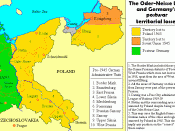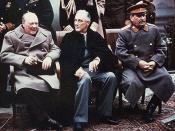Carme Arcarazo Sempere
How did Yalta and Potsdam conferences influenced later political division in Europe? The Yalta and Potsdam conferences were called in 1945 in order to help the Allies decide on crucial issues that emerged in Europe after the Second World War and how the change in the balance of power would be treated; a pivotal concern was the fate of Germany and Poland.1 The Yalta conference, also called the Crimea conference, was held in Soviet Ukraine between the 4th and the 11th of February 1945. The three representatives that attended Yalta were the President of United States Franklin Delano Roosevelt, the Soviet leader Joseph Stalin and the British Prime Minister Winston Churchill.2 The war in Europe ended with Nazi Germany's surrender in May 1945; the victorious Americans, British and Soviets gathered again to finalise the principles of post-war peace.3 The Potsdam conference, also referred to as the "Berlin Conference of the Three Heads of Government of the USSR, USA and UK,"4 was held on the outskirts of Berlin, Germany, from the 17th of July until the 2nd of August 1945. The main participants were the US President Harry S. Truman - elected president when Roosevelt died in April 1945, the British Prime Minister Winston Churchill - later replaced by Clement Attlee, who became prime minister during the conference, and the Soviet premier Joseph Stalin. 5 By attempting to measure the political divisions that were ultimately created, this essay will try to assess the extent to which the 1945 conferences and their decisions redefined the future of the post-war continent. The role of the members of the conference in relation to their interests, the territorial clauses, the democratisation process and the reparations, will be evaluated with regards to the resulting political division in Europe.
Firstly, each of the...


